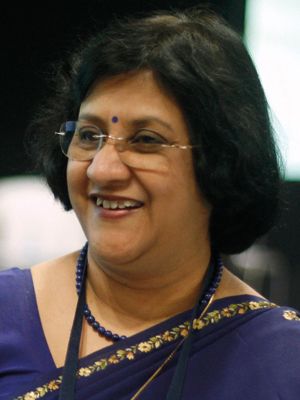The delayed merger of State Bank of India with its affiliates is keeping India’s largest banking group away from the capital markets, its chairman said in an interview.
Arundhati Bhattacharya, on a visit to Singapore last week to launch remittances to India through the bank’s ATM network, said work on the merger of SBI and five regional subsidiaries would start on April 1. The consolidation is later than planned as a result of the negative impact of last year’s demonetisation on the group’s operations.
SBI’s long-planned qualified institutional placement of Rs150bn (US$2.2bn) and any other capital raising will take place only on completion of the merger with the associate banks.
“We will look into capital-raising plans after the merger is over. With the merger hanging on our heads, we cannot approach the capital markets,” Bhattacharya said.
SBI is merging with State Bank of Bikaner and Jaipur, State Bank of Travancore, State Bank of Mysore, State Bank of Patiala and State Bank of Hyderabad.
The consolidation is seen as crucial for the state-owned banking sector as several lenders are short of capital and are finding it hard to expand. Bhattacharya said a successful merger could lead to similar moves for other public sector lenders.
“Consolidation of public sector banks is definitely something that the government is considering,” she said. “They are waiting to see how the merger of SBI group works, before they take a call.”
Analysts believe more public-sector mergers could be on the cards as lenders look to bring down operational costs.
“We see economic rationale for more mergers in the public-sector space, following SBI’s merger,” said Amit Pandey, credit analyst at S&P. “State-owned banks with similar business models could merge as it gives them scale and efficiency.”
However, any consolidation needs to go hand in hand with a look into the capital issue, as India’s banks are struggling to meet tougher regulatory requirements. Bhattacharya remains optimistic that the government will continue to support state-owned banks through regular capital infusions.
The government has announced a lower-than-expected capital injection of US$10.4bn for state-owned banks in the 2017-18 financial year – paltry relative to requirement of US$90bn to comply to Basel-III standards by FY19, according to Fitch Rating estimates.
Bhattacharya, however, thinks the state is likely to inject even more if needed. “The government, being the majority owner of PSBs (public-sector banks), will never ever allow capital levels to fall below the regulatory minimum,” she said.
STRESSED ASSETS
SBI, like India’s other PSBs, is grappling with rising bad debt ratios under tougher reporting requirements and challenging economic conditions.
SBI’s stressed asset ratio reached 9.54% of all lending in the December quarter, according to a recent investor presentation. Although S&P’s Pandey sees the pace of new non-performing-loan creation easing in the next financial year, he has said the resolution of stressed assets is still a work in progress.
The stressed ratio for most PSBs is likely to rise from 12.3% recorded in September last year due to the impact of the currency ban on small and medium-sized businesses, according to Fitch.
Last month, the Reserve Bank of India floated the idea of a “bad bank” to absorb and manage stressed assets in a bid to free up PSBs to focus on their regular business and support the economy. Analysts expect the “bad bank” to be in the form of an asset-reconstruction company, but Bhattacharya says it is “too early” to tell if the concept will be adopted and how it will be structured.
Still, Bhattacharya expects “some movement” on the resolution of stressed assets in the next few months.
Ratings analysts expect measures to give banks greater ability to convert bad loans into equity-like instruments, replace company management and speed up negotiations.
PAYMENT COMPETITION
On the international front, SBI is opening branches and is expanding in neighbouring countries to promote trade.
“We have just opened a new branch in Myanmar and upgraded a branch in Seoul, to get neighbourhood trade going,” Bhattacharya said. The international banking group makes up about 16% of SBI’s balance sheet and about 25% of its profits.
On the domestic front, Bhattacharya says SBI is not worried about competition from payment banks. Bharti Airtel was the first to launch a payment bank in January, after the RBI last year handed over new permits. Payment banks have announced that they will sell products like third-party insurance, loans and mutual funds to manage revenue streams since they are not allowed to offer fixed deposits.
“Payment banks will not change anything for traditional finance because even SBI offers insurance and investment products,” said Bhattacharya. SBI offers cheap and simple “sachet-size products” to savings bank customers, she points out.
